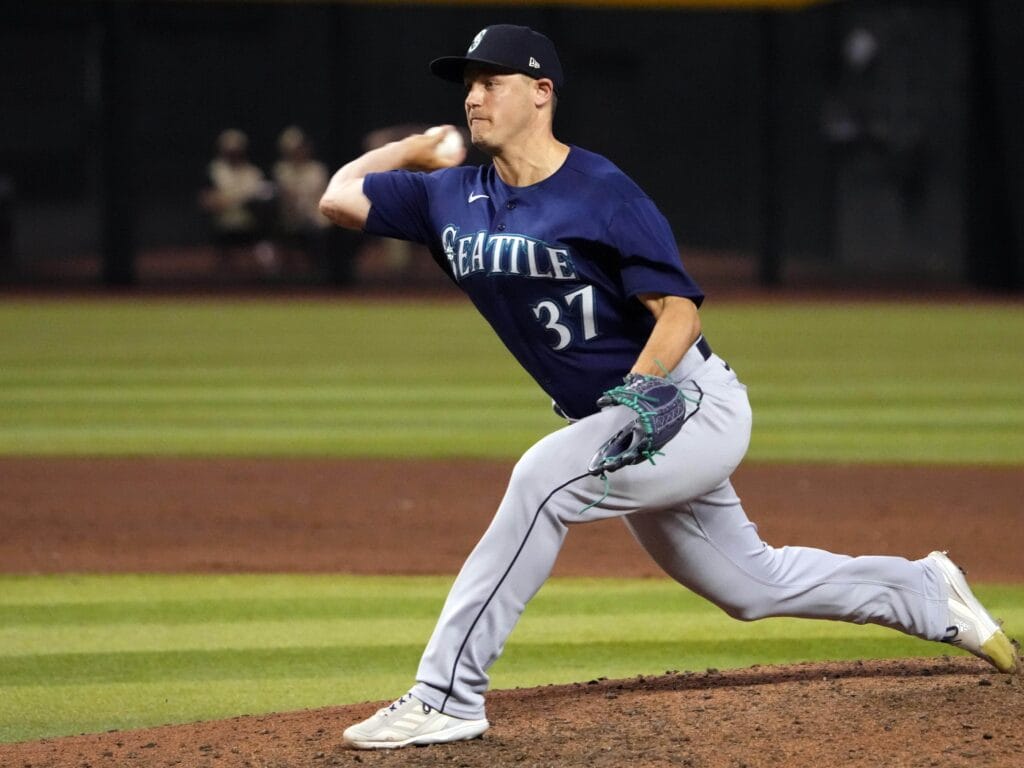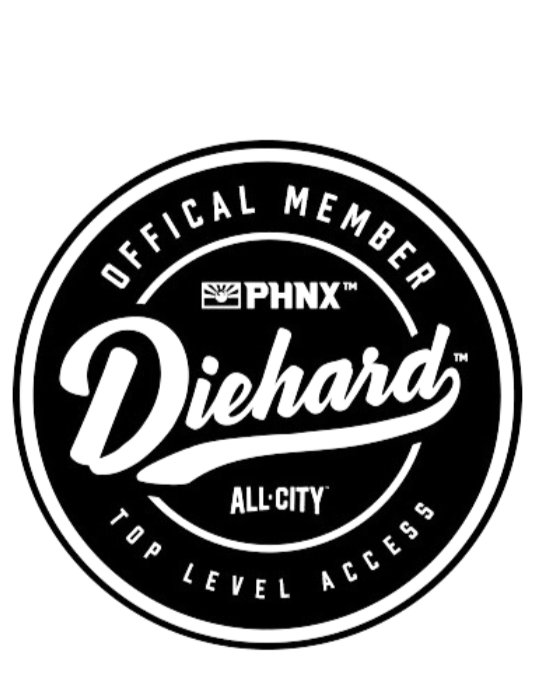© 2024 ALLCITY Network Inc.
All rights reserved.

Aug. 1 has come and gone, and, in spite of his team’s recent struggles, Diamondbacks general manager Mike Hazen followed through on his plan to add at the trade deadline.
The team’s headliner acquisition was closer Paul Sewald from the Seattle Mariners. In addition, the Diamondbacks acquired outfielder Tommy Pham from the New York Mets and utility infielder Jace Peterson from the Oakland A’s. In a surprising move, they also dealt left-handed reliever Andrew Chafin to the Milwaukee Brewers for a younger, more controllable right-handed reliever in Peter Strzelecki.
The Chafin trade notwithstanding, the Diamondbacks, in aggregate, were buyers.
“If nothing else, the first four months of the season have proven that it’s a pretty exciting team and talented team,” Hazen said. “We felt like it needed a little bit of a jolt, and hopefully we’ve added some of that.”
After losing to the San Francisco Giants on Tuesday night, the D-backs are 57-51, one game behind the Brewers for the third wild card spot and 4 1/2 games behind the Los Angeles Dodgers for the NL West lead.
According to FanGraphs, the team’s playoff chances have fallen to 38.5 percent, just the ninth-highest mark in the National League. FanGraphs pegs the San Diego Padres, Miami Marlins and Cincinnati Reds all as more likely than the Diamondbacks to play October baseball.
That begs the question: Did the Diamondbacks buy enough to make buying worth it?
To answer it, let’s take a closer look at what the Diamondbacks did — and did not — accomplish this trade deadline.

What the Diamondbacks did do
In Paul Sewald, the Diamondbacks got a well-established, proven closer. They paid a handsome price to get it, sending infielder Josh Rojas, outfielder Dominic Canzone and infield prospect Ryan Bliss to the Mariners in the deal.
In three seasons with Seattle, Sewald has a 2.88 ERA and 0.93 WHIP in 171.2 innings. He has served as the Mariners’ primary closer for the past two seasons, going 41-for-49 in save opportunities in that span, including a 21-for-24 mark this season.
As expected, Diamondbacks manager Torey Lovullo said that Sewald will be his new team’s closer, something the Diamondbacks have struggled to find for the better part of a decade.
“You’re looking for somebody to go out and compete, swing-and-miss ability, and stand on the mound and get those last three outs of the game,” Lovullo said. “He’s been tested. He’s been doing it at a high level for a while. We believe that’s going to continue.”
Sewald has a four-seam fastball and a sweeper, throwing each almost exactly half the time. His fastball averages only 92 mph, but an unconventional movement profile combined with Sewald’s low arm slot give the pitch uncanny deception.
“One of my favorite things is to just blow somebody away with a 90 or 91 mph fastball, and they just look up at the scoreboard like it doesn’t make any sense,” Sewald said.
Opposing hitters have done quite a bit of that against Sewald’s heater this year. The 33-year-old right has induced whiffs on 31.4 percent of swings. Among pitchers who have thrown 200 or more four-seamers this year, that is the fourth-highest four-seam fastball whiff rate in baseball, trailing only that of Baltimore Orioles closer Felix Bautista, Pittsburgh Pirates closer David Bednar and Mariners ace Luis Castillo.
Sewald fills a huge need for the D-backs. However, in plugging that hole, the D-backs opened a pair of others: an outfielder to replace Canzone and a utility infielder to replace Rojas. Enter Tommy Pham and Jace Peterson.
At the age of 35, Pham is having his best season since 2019. In 264 plate appearances with the Mets this year, he is slashing .268/.348/.472 with 10 homers, 36 RBI and 11 stolen bases.
“He has a proven track record of hitting,” Hazen said. “What we had heard in New York is how motivated and and disciplined he was in the clubhouse at making himself a really good baseball player. That’s something that will fit into our clubhouse.”
Pham has had success against both lefties and righties in 2023, sporting a 135 wRC+ against south paws and a respectable 121 wRC+ against righties.
It remains to be seen how manager Torey Lovullo will use him, but Pham could provide a much-needed boost to a Diamondbacks offense that ranked 25th in runs scored in July. Pham is due to become a free agent at the end of the 2023 season.
In return, the Diamondbacks sent 17-year-old rookie league shortstop Jeremy Rodriguez to the Mets. Rodriguez has slashed .250/.368/.383 this year in the Dominican Summer League.
The final piece of the puzzle for the Diamondbacks was utility infielder Jace Peterson, whom the D-backs acquired from the Oakland A’s in exchange for right-handed pitching prospect Chad Patrick. Peterson hit .222/.313/.324 with six homers, 28 RBI and 11 stolen bases this year in 93 games with Oakland.
As a left-handed hitter who can steal bases and play several positions, Peterson is well-equipped to fill the role that Rojas left behind.
“It’s a fairly straight line around what [Rojas] is doing for us,” Hazen said. “I’m guessing the majority of his at-bats are going to be versus righties. He’ll split off some from [Evan Longoria] and [Emmanuel Rivera] and back up Ketel [Marte], etc.”
Hazen added that the Diamondbacks had interest in Peterson over the offseason.
Peterson ultimately signed a two-year, $9.5 million deal with Oakland that runs through the end of next year. The A’s will cover a portion of his $5 million salary in 2024.

What the Diamondbacks did not do
No team fixes all their problems at the trade deadline, but the D-backs left a fairly signifiant one untouched: starting pitching.
Hazen said that the team was engaged in discussions for both rental starters and controllable starters, but options were scarce and asking prices were high.
“That market was really tough,” Hazen said. “There weren’t a lot of starters out there available. Some of the starters that were out there got held.
“We were willing to overpay, in our mind, for a starter. That wasn’t a concept that we felt like it had to be fair value. Those things go to a certain point, especially with a rental, that you feel like, how far are you willing to push it?
“It wasn’t just the [High-A] Hillsboro and [Low-A] Visalia rosters that we were talking about here. We were talking about guys that were on our team, around our team, going to be on our team, etc., in a lot of these deals. And that’s what made it somewhat challenging for us.”
With no external reinforcements on the way and both Zach Davies and Tommy Henry on the injured list, the D-backs will rely on Zac Gallen, Merrill Kelly, Ryne Nelson and Brandon Pfaadt for the time being. Triple-A pitching prospect Slade Cecconi will start on Wednesday and is an option moving forward as well.
While Gallen and Kelly have formed one of the better 1-2 pitching duos in the sport, none of the other arms in the mix are proven major-league pitchers at this point. The only veteran in the group is Davies, who has struggled as much as anyone with a 7.38 ERA in 12 starts.
Entering play on Wednesday, D-backs starters have combined for a 4.75 ERA and 1.35 WHIP, ranking 24th and 21st in the league, respectively. With the trade deadline now past, the Diamondbacks will take that same pitching staff into the final two months, hoping for better fortunes.
In the bullpen, the outlook is similar. Sewald is an excellent closer, but the D-backs will still have to rely on Kevin Ginkel, Scott McGough, Miguel Castro and others in high-leverage situations. All three have had good moments, but none have proven track records.

With Sewald still awaiting his first opportunity with his team, the D-backs bullpen ranks 23rd in baseball with a 4.44 ERA and 22nd with a 1.34 WHIP. Perhaps the addition of Sewald could push the bullpen closer to league average, but it is unrealistic to expect one reliever to turn a well below-average bullpen into an above-average one.
Offensively, the Diamondbacks shored up their biggest need — a right-handed outfield bat — but did not improve elsewhere, such as at catcher and third base.
With Pham, the D-backs still did quite well in this regard. On paper, he will immediately become the fourth-best hitter on the team, behind only Corbin Carroll, Ketel Marte and Christian Walker.
Prior to Pham’s arrival, the D-backs ranked 16th in wRC+ and 10th in runs scored. With him in the fold, an offense that has been slightly above-average offense to date should get a little better.
Final takeaways
Even after the Diamondbacks’ trade deadline moves, the team figures to have below-average starting pitching, average or slightly below-average relief pitching and slightly above-average offense. Put together, those attributes do not exactly scream playoff contender.
With that in mind, we can revisit the question at hand: Did the Diamondbacks do enough at the trade deadline?
It depends. If the goal of buying is to forge a likely path to the playoffs in 2023, the answer is no. The most likely outcome for 2023, according to projections systems, is that the Diamondbacks will miss the postseason in spite of the moves that have been made.
Nonetheless, is it more likely now that the D-backs will make the playoffs? Of course. The D-backs could finish strong, notch their first playoff berth in six years and look back on this trade deadline as a necessary step to getting there.
It is also important to note that some of these trades — the Sewald deal, in particular — impact not only the 2023 season, but 2024 as well. Even if the 2023 season does not bear playoff fruit, buying now could still pay dividends next season.
Fair or not, how this Diamondbacks trade deadline is perceived will depend heavily on how these next two seasons go. In that sense, the answer to “Did the Diamondbacks do enough?” is simple: Wait and see.
Follow Jesse Friedman on Twitter
Top photo: Steven Bisig/USA TODAY Sports
Get Arizona's Best Sports Content In Your Inbox!Become a smarter Arizona sports fan with the latest game recaps, analysis and exclusive content from PHNX's writers and podcasters!
Just drop your email below!
Comments
Share your thoughts
Join the conversation

The Comment section is only for diehard members
Scroll to next article


